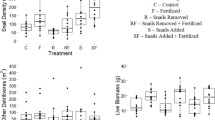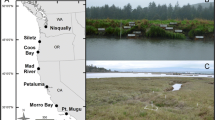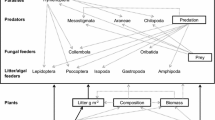Abstract
Burial of aboveground plant litter by animals reduces the amount available for surface transport and places it into a different environment, affecting decomposition rates and fluxes of organic matter to adjacent ecosystems. Here we show that in a Southwestern Atlantic salt marsh the burrowing crab Neohelice granulata buries aboveground plant litter at rates (0.5–8 g m−2 day−1) comparable to those of litter production (3 g m−2 day−1). Buried litter has a low probability (0.6%) of returning to the marsh surface. The formation of burrow excavation mounds on the marsh surface is responsible for most litter burial, whereas litter trapped in burrows was an order of magnitude lower than rates of burial under excavation mounds. Crab exclusion markedly increased surface litter accumulation (3.5-fold in just 21 days). Tides with the potential to transport significant amounts of surface litter are infrequent; hence, most litter is buried before it can be transported elsewhere or decomposes on the surface. Crab litter burial can account for the observed low levels of surface litter accumulation in this ecosystem and likely drives organic matter transformation and export. The impacts of ecosystem engineering by this crab species are therefore substantial and comparable in magnitude to the large effects found for tropical crabs and other litter-burying organisms, such as anecic earthworms.






Similar content being viewed by others
REFERENCES
Alberti J, Cebrian J, Méndez-Casariego A, Canepuccia A, Escapa M, Iribarne O. 2011. Effects of nutrient enrichment and crab herbivory on a SW Atlantic salt marsh productivity. J Exp Mar Biol Ecol 405:99–104.
Alberti J, Montemayor D, Alvarez F, Méndez-Casariego Luppi T, Canepuccia A, Isaach J, Iribarne O. 2007. Changes in rainfall pattern affect crab herbivory rates in a SW Atlantic Salt marsh. J Exp Mar Biol Ecol 353:126–33.
Anderson JM. 1988. Invertebrate-mediated transport processes in soils. Agr Ecosyst Environ 24:5–19.
Barutot RA, D’Incao F, Fonseca DB. 2011. Natural diet of Neohelice granulata (Dana, 1851) (Crustacea, Varunidae) in two salt marshes of the estuarine region of the Lagoa dos Patos lagoon. Braz Arch Biol Technol 54:91–8.
Bas C, Lancia JP, Luppi T, Méndez-Casariego A, Kittlein M, Spivak E. 2014. Influence of tidal regime, diurnal phase, habitat and season on feeding of an intertidal crab. Mar Ecol 35:319–31.
Batzer DP, Wissinger SA. 1996. Ecology of insect communities in nontidal wetlands. Annu Rev Entomol 41:75–100.
Bertness MD, Miller T. 1984. The distribution and dynamics of Uca pugnax (Smith) burrows in a New England salt marsh. J Exp Mar Biol Ecol 83:211–37.
Bohlen PJ, Scheu S, Hale CM, McLean MA, Migge S, Groffman PM, Parkinson D. 2004. Non-native invasive earthworms as agents of change in northern temperate forests. Front Ecol Environ 2:427–35.
Bortolus A, Iribarne OO. 1999. Effects of the SW Atlantic burrowing crab Chasmagnathus granulata on a Spartina salt marsh. Mar Ecol Prog Ser 178:79–88.
Botto F, Iribarne O, Gutiérrez JL, Bava J, Gagliardini A, Valiela I. 2006. Ecological importance of passive deposition of organic matter into burrows of the SW Atlantic crab Chasmagnathus granulatus. Mar Ecol Prog Ser 312:201–10.
Bouchard V, Lefeuvre JC. 2000. Primary production and macrodetritus dynamics in a European salt marsh: carbon and nitrogen budgets. Aquat Bot 67:23–42.
Bouma TJ, De Vries MB, Low E, Peralta G, Tánczos IV, van de Koppel J, Herman PJ. 2005. Trade-offs related to ecosystem engineering: a case study on stiffness of emerging macrophytes. Ecology 86:2187–99.
Breitfuss MJ, Connolly RM, Dale PE. 2004. Densities and aperture sizes of burrows constructed by Helograpsus haswellianus (Decapoda: Varunidae) in saltmarshes with and without mosquito-control runnels. Wetlands 24:14–22.
Brinson MM, Lugo AE, Brown S. 1981. Primary productivity, decomposition and consumer activity in freshwater wetlands. Annu Rev Ecol Syst 12:123–61.
Brown GG, Barois I, Lavelle P. 2000. Regulation of soil organic matter dynamics and microbial activity in the drilosphere and the role of interactions with other edaphic functional domains. Eur J Soil Biol 36:177–98.
Conners ME, Naiman RJ. 1984. Particulate allochthonous inputs: relationships with stream size in an undisturbed watershed. Can J Fish Aquat Sci 41:1473–84.
Cribari-Neto F, Zeileis A. 2010. Beta Regression in R. J Stat Softw 34:1–24.
Cunha SR, Asmus M, Costa CSB. 2005. Production dynamics of Spartina alterniflora salt marshes in the estuary of Patos Lagoon (RS, Brazil): a simulation model approach. Braz J Aquat Sci Technol 9:75–85.
Daleo P, Fanjul E, Méndez-Casariego A, Silliman BR, Bertness MD, Iribarne O. 2007. Ecosystem engineers activate mycorrhizal mutualism in salt marshes. Ecol Lett 10:902–8.
D’Incao F, Silva KG, Ruffino ML, Braga AC. 1990. Hábito alimentar do caranguejo Chasmagnathus granulata Dana, 1851 na barra do Rio Grande, RS (Decapoda, Grapsidae). Atlântica 12:85–93.
Facelli JM, Pickett ST. 1991. Plant litter: its dynamics and effects on plant community structure. Bot Rev 57:1–32.
Fanjul E, Escapa M, Montemayor D, Addino M, Alvarez MF, Grela MA, Iribarne O. 2015. Effect of crab bioturbation on organic matter processing in South West Atlantic intertidal sediments. J Sea Res 95:206–16.
Fanjul E, Grela MA, Canepuccia A, Iribarne O. 2008. The Southwest Atlantic intertidal burrowing crab Neohelice granulata modifies nutrient loads of phreatic waters entering coastal area. Estuar Coast Shelf Sci 79:300–6.
Fanjul E, Grela MA, Iribarne OO. 2007. Effects of the dominant SW Atlantic intertidal burrowing crab Chasmagnathus granulatus on sediment chemistry and nutrient distribution. Mar Ecol Prog Ser 341:177–90.
Fasano JL, Hernández MA, Isla FI, Schnack EJ. 1982. Aspectos evolutivos y ambientales de la laguna Mar Chiquita (Provincia de Buenos Aires, Argentina). Oceanol Acta SP:285-292.
Ferrari SLP, Cribari-Neto F. 2004. Beta regression for modelling rates and proportions. J Appl Stat 31:799–815.
Findlay SEG, Howe K, Austin HK. 1990. Comparison of detritus dynamics in two tidal freshwater wetlands. Ecology 71:288–95.
Foster M, Stubbendieck J. 1980. Effects of the plains pocket gopher (Geomys bursarius) on rangeland. J Range Manag 33:74–8.
Gallagher JL, Reimold RJ, Linthurst RA, Pfeiffer WJ. 1980. Aerial production, mortality, and mineral accumulation: export dynamics in Spartina alterniflora and Juncus roemerianus stands. Ecology 61:303–12.
Gillis LG, Bouma TJ, Jones CG, Van Katwijk MM, Nagelkerken I, Jeuken CJL, Herman PMJ, Ziegler AD. 2014. Potential for landscape-scale positive interactions among tropical marine ecosystems. Mar Ecol Prog Ser 503:289–303.
Green PT, Lake PS, O’Dowd DJ. 1999. Monopolization of litter processing by a dominant land crab on a tropical oceanic island. Oecologia 119:435–44.
Gutiérrez JL, Jones CG, Groffman PM, Findlay SEG, Iribarne OO, Ribeiro PD, Bruschetti CM. 2006. The contribution of crab burrow excavation to carbon availability in superficial salt-marsh sediments. Ecosystems 9:647–58.
Halupa PJ, Howes BL. 1995. Effects of tidally mediated litter moisture content on decomposition of Spartina alterniflora and S. patens. Mar Biol 123:379–91.
Hemminga MA, Huiskes AHL, Steegstra M, Van Soelen J. 1996. Assessment of carbon allocation and biomass production in a natural stand of the salt marsh plant Spartina anglica using 13C. Mar Ecol Prog Ser 130:169–78.
Hendrix PF, Parmelee RW, Crossley DA, Coleman DC, Odum EP, Groffman PM. 1986. Detritus food webs in conventional and no-tillage agroecosystems. BioScience 36:374–80.
Holland EA, Coleman DC. 1987. Litter placement effects on microbial and organic matter dynamics in an agroecosystem. Ecology 68:425–33.
Iribarne OO, Bortolus A, Botto F. 1997. Between-habitat differences in burrow characteristics and trophic modes in the burrowing crab Chasmagnathus granulata. Mar Ecol Prog Ser 155:137–45.
Iribarne O, Botto F, Martinetto P, Gutiérrez JL. 2000. The role of burrows of the SW Atlantic intertidal crab Chasmagnathus granulata in trapping debris. Mar Pollut Bull 40:1057–62.
Isacch JP, Costa CSB, Rodríguez-Gallego L, Conde D, Escapa M, Gagliardini DA, Iribarne OO. 2006. Distribution of saltmarsh plant communities associated with environmental factors along a latitudinal gradient on the south-west Atlantic coast. J Biogeogr 33:888–900.
Jackson D, Long SP, Mason CF. 1986. Net primary production, decomposition and export of Spartina anglica on a Suffolk salt-marsh. J Ecol 74:647–62.
Jones CG, Gutiérrez JL, Byers JE, Crooks JA, Lambrinos JG, Talley TS. 2010. A framework for understanding physical ecosystem engineering by organisms. Oikos 119:1862–9.
Jones CG, Lawton JH, Shachak M. 1994. Organisms as ecosystem engineers. Oikos 69:373–86.
Kristensen E. 2008. Mangrove crabs as ecosystem engineers; with emphasis on sediment processes. J Sea Res 59:30–43.
Leendertse PC, Roozen AJM, Rozema J. 1997. Long-term changes (1953–1990) in the salt marsh vegetation at the Boschplaat on Terschelling in relation to sedimentation and flooding. Plant Ecol 132:49–58.
Liao CZ, Luo YQ, Fang CM, Chen JK, Li B. 2008. Litter pool sizes, decomposition, and nitrogen dynamics in Spartina alterniflora-invaded and native coastal marshlands of the Yangtze Estuary. Oecologia 156:589–600.
Long JS. 1997. Regression models for categorical and limited dependent variables. Thousand Oaks (CA): Sage Publications.
Luppi T, Bas C, Méndez-Casariego A, Albano M, Lancia JP, Kittlein M, Rosenthal A, Farías N, Spivak E, Iribarne O. 2013. The influence of habitat, season and tidal regime in the activity of the intertidal crab Neohelice (= Chasmagnathus) granulata. Helgoland Mar Res 67:300.
Manly BFJ. 1998. Randomization, bootstrap and Monte Carlo methods in biology. London (UK): Chapman & Hall.
McCullagh P, Nelder JA. 1989. Generalized linear models. London (UK): Chapman and Hall.
Méndez-Casariego A, Alberti J, Luppi T, Daleo P, Iribarne O. 2011. Habitat shifts and spatial distribution of the intertidal crab Neohelice (Chasmagnathus) granulata Dana. J Sea Res 66:87–94.
Metzler GM, Smock LA. 1990. Storage and dynamics of subsurface detritus in a sand-bottomed stream. Can J Fish Aquat Sci 47:588–94.
Middleton BA, McKee KL. 2001. Degradation of mangrove tissues and implications for peat formation in Belizean island forests. J Ecol 89:818–28.
Mitsch WJ, Gosselink JG. 1993. Wetlands. New York (NY): Van Nostrand Reinhold.
Montemayor DI, Addino M, Fanjul E, Escapa M, Alvarez MF, Botto F, Iribarne OO. 2011. Effect of dominant Spartina species on salt marsh detritus production in SW Atlantic estuaries. J Sea Res 66:104–10.
O’Dowd DJ, Lake PS. 1989. Red crabs in rain forest, Christmas Island: removal and relocation of leaf-fall. J Trop Ecol 5:337–48.
Polis GA, Anderson WB, Holt RD. 1997. Toward an integration of landscape and food web ecology: the dynamics of spatially subsidized food webs. Annu Rev Ecol Syst 28:289–316.
R Development Core Team. 2017. R: A language and environment for statistical computing v 3.4.1. R Foundation for Statistical Computing, Vienna, Austria. URL http://www.R-project.org/, accessed 30 June 2017.
Robertson AI. 1986. Leaf-burying crabs: their influence on energy flow and export from mixed mangrove forests (Rhizophora spp.) in Northeastern Australia. J Exp Mar Biol Ecol 116:235–47.
Sherman PM. 2003. Effects of land crabs on leaf litter distributions and accumulations in a mainland tropical rain forest. Biotropica 35:365–74.
Suárez ER, Fahey TJ, Yavitt JB, Groffman PM, Bohlen PJ. 2006. Patterns of litter disappearance in a northern hardwood forest invaded by exotic earthworms. Ecol Appl 16:154–65.
Sun Z, Mou X. 2016. Effects of sediment burial disturbance on macro and microelement dynamics in decomposing litter of Phragmites australis in the coastal marsh of the Yellow River estuary, China. Environ Sci Pollut Res 23:5189–202.
Sun ZG, Mou XJ, Wang LL, Sun WL, Sun WG. 2015. Effects of sedimentation intensity on decomposition and nitrogen dynamics of Suaeda salsa litter in salt marshes in tidal bank of the Yellow River estuary. Wetland Sci 13:135–44.
Takeda S, Kurihara Y. 1987. The effects of burrowing of Helice tridens (De Haan) on the soil of a salt marsh habitat. J Exp Mar Biol Ecol 113:79–89.
Taylor DI, Allanson BR. 1993. Impacts of dense crab populations on carbon exchanges across the surface of a salt-marsh. Mar Ecol Prog Ser 101:119–29.
Twilley RR, Pozo M, Garcia VH, Rivera-Monroy VH, Bodero RZA. 1997. Litter dynamics in riverine mangrove forests in the Guayas River estuary, Ecuador. Oecologia 111:109–22.
Valiela I, Teal JM, Allen SD, Van Etten R, Goehringer D, Volkmann S. 1985. Decomposition in salt marsh ecosystems: the phases and major factors affecting disappearance of above-ground organic matter. J Exp Mar Biol Ecol 89:29–54.
van de Koppel J, van der Heide T, Altieri AH, Eriksson BK, Bouma TJ, Olff H, Silliman BR. 2015. Long-distance interactions regulate the structure and resilience of coastal ecosystems. Annu Rev Mar Sci 7:139–58.
Vera F, Gutiérrez JL, Ribeiro PD. 2009. Aerial and detritus production of the cordgrass Spartina densiflora in a Southwestern Atlantic salt marsh. Botany 87:482–91.
Walker LR, Shiels AB. 2008. Post-disturbance erosion impacts carbon fluxes and plant succession on recent tropical landslides. Plant Soil 313:205–16.
Wang J, Zhang X, Jiang L, Bertness M, Fang C, Chen J, Hara T, Li B. 2010. Bioturbation of burrowing crabs promotes sediment turnover and carbon and nitrogen movements in an estuarine salt marsh. Ecosystems 13:586–99.
Warren RS, Niering WA. 1993. Vegetation changes on a Northeast tidal marsh: interaction of sea-level rise and marsh accretion. Ecology 74:96–103.
Wasserman L. 2004. All of statistics: a concise course in statistical inference. New York (NY): Springer.
Welbourn ML, Stone EL, Lassoie JP. 1981. Distribution of net litter inputs with respect to slope position and wind direction. Forest Sci 27:651–9.
Wolfrath B. 1993. Observations on the behaviour of the European fiddler crab Uca tangeri. Mar Ecol Prog Ser 100:111–18.
Zacheis A, Ruess RW, Hupp JW. 2002. Nitrogen dynamics in an Alaskan salt marsh following spring use by geese. Oecologia 130:600–8.
Zar JH. 1984. Biostatistical analysis. Englewood Cliffs (NJ): Prentice Hall.
ACKNOWLEDGEMENTS
We thank Martín Bruschetti, Andrés Rodríguez, and Federico Vera for field assistance, Marcelo Kittlein for statistical advice, and Oscar Iribarne for laboratory space and facilities at Universidad Nacional de Mar del Plata during the execution of this project. We are also indebted to Mónica Fiore (Servicio de Hidrografía Naval, Argentina) for tidal measurements from Mar del Plata port. This paper benefited from the comments made by the Subject-Matter Editor, Dr. Tim Essington, and two anonymous reviewers. Research was supported by the Andrew W. Mellon Foundation and the Cary Institute of Ecosystem Studies (CGJ, JLG, PMG and SEGF). JLG and PDR were supported by scholarships from CONICET at the time of this study. This is a contribution to the programs of GrIETA and the Cary Institute of Ecosystem Studies.
Author information
Authors and Affiliations
Corresponding author
Additional information
Authors contributions
All authors contributed to study conception, study design, interpretation of findings, and commenting on manuscript drafts. JLG performed the field research. JLG, CGJ, and PDR were primarily responsible for data analysis. JLG and CGJ wrote and edited the drafts of the manuscript.
Electronic supplementary material
Below is the link to the electronic supplementary material.
Rights and permissions
About this article
Cite this article
Gutiérrez, J.L., Jones, C.G., Ribeiro, P.D. et al. Crab Burrowing Limits Surface Litter Accumulation in a Temperate Salt Marsh: Implications for Ecosystem Functioning and Connectivity. Ecosystems 21, 1000–1012 (2018). https://doi.org/10.1007/s10021-017-0200-6
Received:
Accepted:
Published:
Issue Date:
DOI: https://doi.org/10.1007/s10021-017-0200-6




